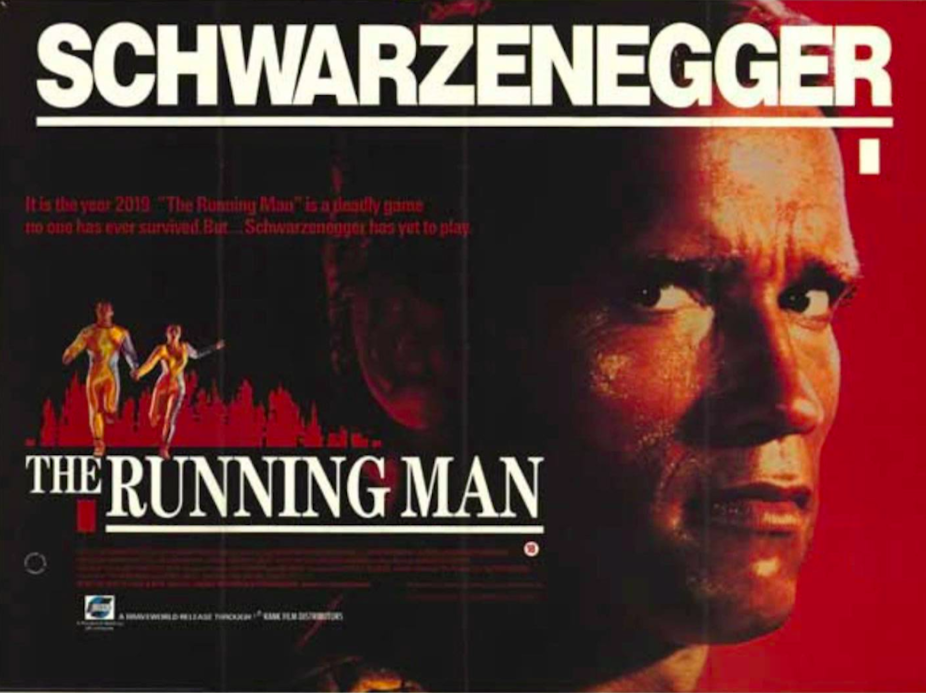Welcome to a world where fake news stories are used to manipulate public opinion. Dissent is no longer tolerated and all your communications are monitored; the economy is not functioning and reality TV is used to distract you from harsher realities. Welcome to 2017.
I don’t mean our 2017 but an imagined one from 30 years ago. This was the setting for 1987 movie The Running Man, starring Arnold Schwarzenegger. The bad news? Much of this action-adventure slugfest looks eerily prophetic now that we’re here for real.
In the film, Schwarzenegger plays police helicopter pilot Ben Richards in a 2017 when many people are living on the streets and food, natural resources and oil are in short supply. The movie begins with him refusing to fire on a food riot from his helicopter because the people are unarmed, with women and children caught up in the protest. He gets overpowered by colleagues and the rioters are massacred, with footage of the incident edited to make him the perpetrator – and a useful scapegoat.

Imprisoned for life, Richards is offered the chance to win his freedom by competing in the most popular TV programme in history, Running Man. This state-sponsored show pits contestants against high-profile hunters with extreme weaponry. It’s a Schwarzenegger vehicle from his 1980s heyday, so you can probably guess who wins.
The script by Steven E de Souza loosely adapts a 1982 novel of the same name by Richard Bachman, the pseudonym of horror author Stephen King. The source material is set in 2025 and far less heroic. It ends with Richards hijacking an aeroplane and flying it into the television company’s skyscraper headquarters – stop me if this is sounding in any way familiar.
The film adaptation is a product of its time, with 1980s props that look out of place in the fictional 2017 setting. People carry clipboards instead of tablet computers, use analogue phones rather than mobiles, and store their music on cassette. The Running Man does feature smart home technology, like voice-controlled coffee makers, but the computers are primitive. It’s the satirical touches that stand out most in this film, such as the president of the United States having his own theatrical agent.
When in Rome …
The central conceit of both novel and film – that those in power use mass entertainment to distract the population from reality – is part of a long tradition. It dates all the way back to the Roman empire when the masses were appeased with free wheat and arena spectacles, a tactic described as panem et circenses – bread and circuses.
One of the first writers to transplant this notion to television was Quartermass creator Nigel Kneale in his 1968 play for BBC Two, The Year of the Sex Olympics. It envisaged a dystopian future where the elite maintains control over the people by broadcasting a constant stream of pornography and trash television.
Kneale effectively predicted the rise of reality TV programmes like Big Brother and I’m a Celebrity, Get Me Out of Here; and much other science fiction has drawn on the same theme. It appears, for example, in Doctor Who in the 1985 adventure Vengeance on Varos – set in a totalitarian world where torture and executions are televised to amuse and divert the masses – and more recently in The Hunger Games trilogy.
The additional element that makes The Running Man even more resonant right now is fake news. The fake footage of Richards’ helicopter massacre is replayed to the live audience in the gameshow studio to coerce them into believing Schwarzenegger’s character is a liar, a murderer and a threat to everyone. The programmers then do the same thing to his sidekick, Amber Mendez (Maria Conchita Alonso), before later faking their televised deaths during the game itself.
It’s not unlike how social media and even some broadcasters have been guilty of distributing and promoting fake news in recent months, especially during the US presidential election. When psychotic Running Man host Damon Killian (Richard Dawson) interviews studio audience members in the movie, their simple-minded responses echo footage of real American voters dismissing reality for what they’ve been told on TV or via alt-right news sites.
Muscular politics
Meanwhile, The Running Man cast included not one but two men who would improbably become governors of American states. Jesse Ventura, then best known as a professional wrestler, appears as gameshow veteran Captain Freedom. In 1999, Ventura was elected governor of Minnesota, serving a full four-year term.

Schwarzenegger, a former bodybuilder, was then elected governor of California in 2003 and re-elected in 2006. And having starred in a movie about the potential dangers of reality TV, on January 2 he will become host of Celebrity Apprentice in the US. The person he replaces? A real estate tycoon called Donald Trump who will become the president of the United States in the coming days, despite losing the popular vote.
Trump has appointed as his chief strategist and senior counsellor Stephen Bannon. Until recently, Bannon was executive chair of Breitbart News, a right-wing website accused of massaging facts to promote its agenda and win the election for his new boss. And lest we forget, one key part of Trump’s mandate is to revive an economy that has never recovered from the financial crisis of 2007-08.
Put it all together and the 2017 of The Running Man doesn’t look very far away.

